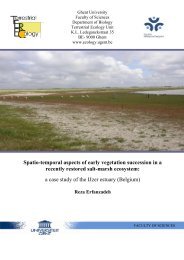PhD Arthur Decae 2010 - Ghent Ecology - Universiteit Gent
PhD Arthur Decae 2010 - Ghent Ecology - Universiteit Gent
PhD Arthur Decae 2010 - Ghent Ecology - Universiteit Gent
Create successful ePaper yourself
Turn your PDF publications into a flip-book with our unique Google optimized e-Paper software.
Origin of the Mediterranean<br />
Questions of origin are always difficult to approach because we have to find a starting point.<br />
In the case of the Mediterranean this is particularly difficult, but we might start from the idea<br />
that the forces that broke-up the ancient super continent Pangaea, some 170 million years ago,<br />
led to the formation of the separate ‘continental plates’ that much later in time, were to form<br />
the Mediterranean. This formation of the Mediterranean finally took place in a gigantic<br />
‘tombola’ of collisions and segregations of fractions of the earths crust (see footnote 7 for<br />
discoveries and discoverers of continental drift and seafloor spreading). The main processes to<br />
be considered here are: (1) the opening of the North Atlantic Ocean and the vanishing of the<br />
ancient Tethys Ocean, (2) the movements of the African and Arabian continental plates, (3)<br />
birth of the Mediterranean Sea. For information on these phenomena I lean heavily on the<br />
following sources: D. Ager’s (1980) celebrated book The Geology of Europe; Rögl &<br />
Steiniger’s (1984) Chapter 10 in Fossils & Climate (Wiley Books) and Rögl’s (1999) short<br />
discussion of the Mediterranean Palaeogeography in Geologica Carpatica.<br />
1. The Atlantic and Tethys Oceans<br />
The formation of the Atlantic Ocean started<br />
near the equator with cracking open the<br />
solid continental block of Pangaea, roughly<br />
at a place where we now find the Caribbean.<br />
A subsequent rapture moved from there to<br />
the southwest to separate North and South<br />
America. A second giant rapture moved<br />
northeast to separate North America from<br />
Africa and Europe. In the process southern<br />
Europe was broken-up in a series of microplates<br />
that formed an archipelago within the<br />
northwestern Tethys Ocean (Fig. 2). It all<br />
must have happened early in Jurassic times,<br />
approximately 170 million years ago<br />
(Pannekoek 1973), when giant dinosaurs<br />
roamed the earth. The rapture of Pangaea<br />
separated the northern continents from one<br />
large southern continent that is here denoted<br />
as Neogondwana 9 . To the east the young<br />
Atlantic Ocean had a seaway connection with<br />
the western parts of the ancient Tethys Ocean.<br />
This inter-oceanic seaway is the location where<br />
the Mediterranean was going to be formed. In<br />
time the Tethys Ocean would be replaced by the<br />
Indian Ocean (late Mesozoic to mid Cenozoic)<br />
Fig. 2 Showing the young Atlantic Ocean (approx.<br />
150myBP) separating the northern from the still<br />
united southern continents and the seaway<br />
connection with the western Tethys. Source:<br />
R.Blakey.ucc.nau.edu/<br />
through the northward movement of the Indo-Australian plate and the rotation of the Arabian<br />
plate away from Africa to close the Atlantic-Tethys connection so shaping the Mediterranean.<br />
9 An earlier separation between northern and southern continental blocks broadly denoted as<br />
Laurasia and Gondwana had existed in the Palaeozoicum (400myBP-350myBP) before the<br />
formation of Pangaea, hence the term Neogondwana for the southern continental block that<br />
originated from the breakdown of Pangaea.










